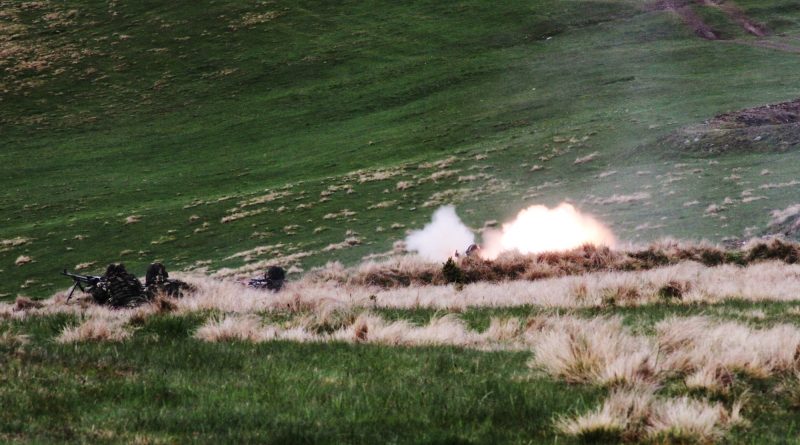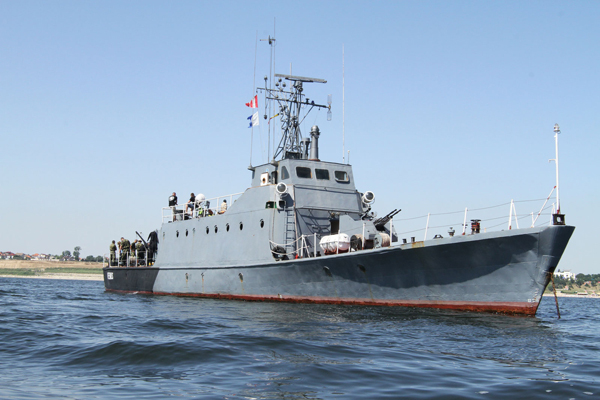Black Sea Rotational Force 2014 Platinum Lynx
 For two weeks, the multinational exercise “Black Sea Rotational Force 2014-2”, “Platinum Lynx 14-5” module was held in Vatra Dornei garrison.
For two weeks, the multinational exercise “Black Sea Rotational Force 2014-2”, “Platinum Lynx 14-5” module was held in Vatra Dornei garrison.
During the Platinum Lynx training module, the Romanian soldiers of the 17th Mountain Troop Bn. “Dragos Voda” and Marines of the U.S. Marine Corps, deployed in Europe, executed joint training that included live-fire exercises, tactical exercises, mountain training and first aid in areas of operations.
The bilateral exercise between the United States Marines and sailors and Romanian Land Forces is designed to build familiarity and interoperability. The first stage of the training module consisted of tactical training of the Romanian and U.S. Marines and sailors and included: knowledge and familiarity with weaponry, processes for crossing dangerous areas, fighting in a village, patrol techniques and first aid.
Next was the mountain training in Rarau Mountain, where, under the guidance of the most experimented Romanian soldiers from the 17th Mountain Troop Bn., the Marines and sailors underwent a specialized training that accustomed theme to hiking and operating in rocky, snowy and mountainous terrain.
The Marines and sailors learned the basics of climbing and maneuvering through mountainous terrain by being given the chance to rock climb small cliffs under the supervision of the Romanians. They also rappelled down steep cliffs and rode on a zip line as part of the training. The highlight of the activity was reaching the Pietrele Doamnei Peak (1647 m) with the Romanian and the American contingent identification flags. The team was led by Colonel Adrian Tinjala, commander of the 17th Mountain Troops Battalion “Dragos Voda” which has proved once again the true quality of a mountain troop, being the “head string” of the Massif Rarau training exercise.
Most Marines and sailors came into contact with the rock for the first time, hiking and operating in rocky, snowy and mountainous terrain, conducting for the first time exercises at altitude and in difficult and changeable weather conditions, specific for the mountain, “the weather of the Mountain Troops”. The American service members got used to it pretty quickly and were very enthusiastic about the new things learned from the Romanian soldiers.
Talking about what they learned from each other, Major Cristian Arsene, Company 1, 17th Mountain Troops Battalion Commander told us: “The American Marines and sailors deployed in MK base were quick to adapt to the conditions of time and season of mountain troops, and we shared our mutual experiences of living in isolation, fighting in the mountains, fighting in the village and specific procedures of operating in Afghanistan, during our commune training.”
On the other hand, Americans were very excited about this training as Captain Christopher Orr, Weapons Company, 3rd Battalion, 8th Marine Regiment Commander said: “Romanians showed us specific techniques in mountain activities, which for us was a very important experience because we don’t get to train in mountain as much as we would like, so it is a great learning experience for us, since we are an amphibious force. We have been shown climbing techniques, rappel, and zip line, operating and traveling in a mountainous area, all this we have learned from the Romanian military.”
Lance Cpl. Scott Whiting had the same opinion: “since I’ve been here the most enjoyable days for me were in the Rarau Mountain, when I climbed for the first time, having the opportunity to learn something new. It was a challenge, but it was very fun, you feel accomplished when reaching the top or rappel down to the bottom. In fact, I think for about 90% of my colleagues this was also the first time they did rock climbing.”
Between the main training modules, animated by civic spirit and enthusiasm, the Romanian soldiers together with the American service members, backed by the local community, have conducted maintenance and repair of fences of the educational institutions in the Ciocanesti village. At the middle school, they poured the foundation for a fence, and at the kindergarten, they carved and put in place a wooden fence specific to the Bucovina area. Upon completion of this activity, they visited the Ciocanesti Ethnographic Museum and the Museum of Painted Eggs, leitmotifs of local culture and tradition.
The second major phase of the training took place at the Rotunda firing range. Here soldiers from 17th Mountain Troops Battalion “Dragos Voda” and Marines and sailors with Black Sea Rotational Force 14 from 3rd Battalion, 8th Marine Regiment conducted live fire exercises, tactical firings and tactical training exercises in the field, as well as planning activities, combined command and control integration. First to start the exercises were the Romanian soldiers with a defense application, followed by U.S. Marines with an assault application.
Following a hypothetical scenario, the Mountain Troop and U.S. Marines trained practicing defense and attack of a foothold, and targeted organization of the fire, layout, and mask of the attack, and maneuvering the forces. This exercise was designed to build familiarity and interoperability between the United States and their Romanian allies through the squad and platoon-level infantry training.
During the life firing, soldiers of both subunits used heavy infantry, anti-tank weapons – antitank grenade launcher – individual weapons – submachine gun, machine gun – and 17th Battalion used armored fighting techniques, namely the fighting machine of the mountain troops.
“The level of interoperability with the U.S. partner was achieved almost entirely, from the point of view of combat techniques and command. In the course of the exercise each subunit has been integrated, and even leadership and command authority was transferred alternately from the American partner to the Romanian partner, so interoperability is almost full” declared during the application at the Rotunda range, Colonel Marius Giurca, Commander of 61th Mountain Troops Brigade “General Virgil Badulescu”.
“The Romanian mountain troops have shown us, during the fire range exercise, their defense capabilities, and we have demonstrated our offensive and combines weapon capabilities. It was a mutual exchange of techniques, tactics, and procedures, and I think both sides have benefited from these two weeks of training,” added Captain Christopher Orr.
“During the live fire exercise at the Rotunda rage, we could change between us the armament used and we were able to fire the Romanian weapons. It was fun for both parties, considering that the Marines were able to use a different weapon system, as the Romanians, both sides quickly learning the partner’s weapons. Personally, the 17th Mountain Troops Battalion has been my favorite unit to train with, since I was deployed at MK base,” admitted Lance Cpl. Scott Whiting.
The last day of the training module “Platinum Lynx 14-5” from the multinational exercise “Black Sea Rotational Force 2014-2” held in Vatra Dornei garrison began in force. The 17th Mountain Troops Battalion “Dragos Voda” and the Marines of the U.S. Marine Corps executed, in Suhard, Ousorul Peak (1635m), an approximate 18-kilometer hike, climbing approximately one mile in altitude, in the mountainous terrain to give the Marines an idea of how the Romanians train.
It offered a new opportunity to the American Marines to reunite with the mountain and its capricious and changeable weather, to further learn new things and pass successfully across a new challenge, as Lance Cpl. Scott Whiting said: “the hike was tough, many of us, I included, are not accustomed to this kind of hikes. I grew up in a mountainous area, but I didn’t hike in the mountains, and it was for the first time I went to mountains of this height. I think we all felt a little sore after the hike, but we also feel very well and satisfied that we managed, the Romanians were in front of us and we were motivated and always tried to keep up with them.”
“As Marines, we used to this, so it was an experience that we liked, especially since we don’t get very often the opportunity to engage in this type of terrain. Therefore the 18 km hike to the top of Ousorul was fun, although at the end you could see many Marines with sore feet. But we had fun and it was a good time to interact and establish new operations with mountain troops,” concluded Captain Christopher Orr.
After returning from the march, the closing ceremony of the exercise “Platinum Lynx 14-5” “Black Sea Rotational Force 2014-2” took place, to this attended the Marines and sailors with Black Sea Rotational Force 14 from 3rd Battalion, 8th Marine Regiment, the Romanian soldiers of the 17th Mountain Troop Bn., Lt. Col. Trevor Hall, commanding officer of BSRF14 and 3rd Battalion, 8th Marine Regiment, 17 Mountain Troops Battalion “Dragos Voda” Colonel Adrian Tinjală, and representatives of local authorities.
The whole experience of the two weeks spent with the 17th Mountain Troops Battalion “Dragos Voda” was concluded by Gunnery Sergeant Stephan Hurlbut: “What the Romanian soldiers can take from the Americans is how to combine the weapons systems to maximize the effect on the enemy. What we got from the here was the hospitality and friendship of the Romanian people. It’s an amazing thing that we could get from the Romanian. We assumed that we have to contribute with something, to give something when we came here, when we went, a few days ago, to help at the school and kindergarten, but Marines took more than they gave, they took the hospitality and friendship of the Romanians.
The march was fantastic. I liked it very much. It was a challenge, but a nice one.”
Story from Tactica Magazine #6
Text: Marcella Drăgan
Photos: Marcella Drăgan, Col. Adrian Tînjală, Lt.col. Laurențiu Andriesei, Plt.adj. Cojocariu Constantin, Plt.maj. Ovidiu Sveduneac, Plt.adj. Marius Sfîrlea, Lance Cpl. Scott Whiting




